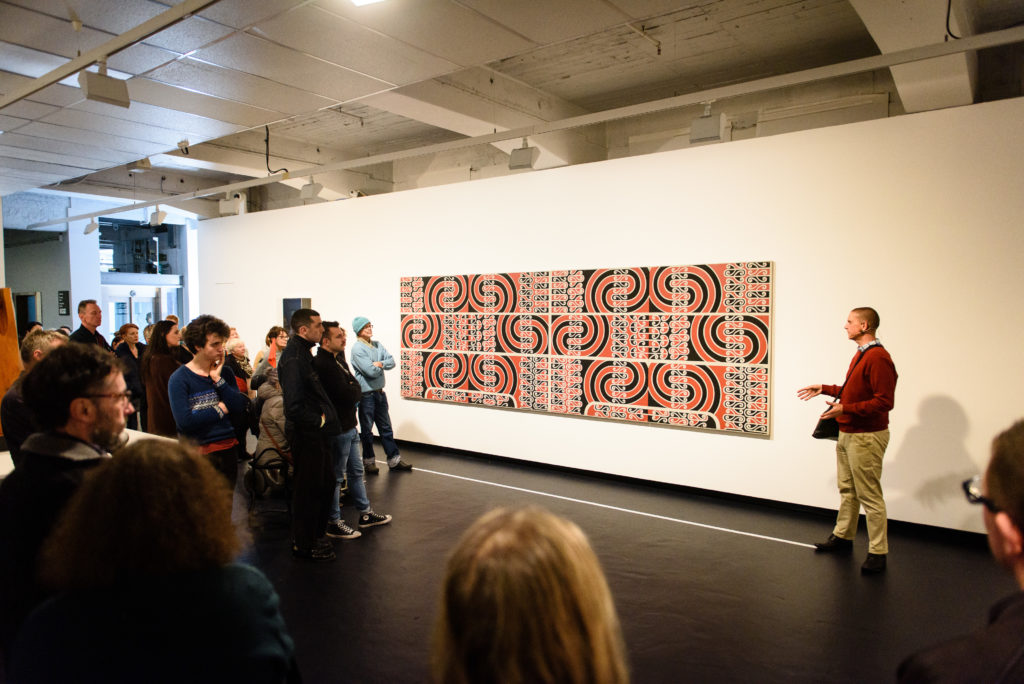Damian Skinner, co-curator of Split Level View Finder: Theo Schoon and New Zealand Art, opened the show on 16 August 2019 with the following words.
Theo Schoon’s old friend John Money could be remarkably clear eyed and insightful about the artist. Money thought that Schoon suffered from ‘pseudologia fantastica’, a kind of pathological lying that turned his life into a work of creative art. According to Money, Schoon had convinced himself that he was a reincarnated tohunga with direct access to the spirit of Māori art. In 1947, when Money and Schoon first met, that was an intriguing metaphor, scientifically and culturally ridiculous, but artistically productive. Money recognised that, without this mystique, Schoon would never have recorded and promoted the rock drawings, or obsessively pursued growing and carving gourds, or studied kōwhaiwhai and tā moko, seeking to unlock the secrets—as he saw them—of Māori art.
Money wrote these things in a letter that he sent me in 1997. He had read my MA thesis on Schoon, and while he liked the illustrations, he thought my text was too busy convicting Schoon of the crime of being ignorant and offensive about Māori art—too much the artist and romantic, too concerned with playing the white tohunga, to properly see what was in front of him. Money believed that Schoon was a genius, despite—or indeed, because of—his delusions. ‘I didn’t get an emanation of genius from the pages of your dissertation’, he told me. The academic approach was fine, but when would I get on and write a full biography, in which the nature of Schoon’s achievement could be properly revealed?
I didn’t believe in genius in 1997, and I still don’t in 2019. It is a term that obscures more than it reveals. But I reread Money’s letter before starting work on my biography. He was right that getting to grips with Schoon needed something more than art history, and it was both a pleasure and sometimes a burden to track Schoon’s pseudologia fantastica across a lifetime, to trace the life as a work of creative art. But then there is the art itself, some of which is on display in this exhibition, and returning to that in the company of Aaron Lister, my co-curator, has conjured up another Schoon, one which I also think deserves our attention.
I found myself thinking of Money’s letter again in relation to the controversy about Schoon’s attitudes and art that has greeted this exhibition. Money clearly names Schoon’s pathology, but he also recognises the role that it played in his achievements as an artist. From the beginning, Schoon has seemed to me to be important precisely because the good and the bad are so intensely entwined. To explore what we might want to propose as laudable or worthy—such as an interest in art and culture that far exceeded the typical awareness of Pākehā society—means also fronting up to much less savoury realities—such as the blindness and superiority that followed a mistaken belief about special access to someone else’s culture. This is just one of a number of contradictions that come with taking Schoon seriously.
Schoon’s life and art remain a challenge, one that I haven’t been able to solve or resolve across a master’s thesis, a biography, and an exhibition. I am extremely grateful to Aaron Lister and the City Gallery for the opportunity to think through these issues with Schoon’s art, and to contribute to an ongoing discussion that is raw and remarkable in equal—and equally unsettling—measure.
—Damian Skinner


